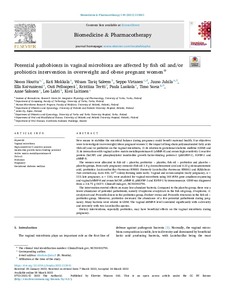Potential pathobionts in vaginal microbiota are affected by fish oil and/or probiotics intervention in overweight and obese pregnant women
Houttu Noora; Mokkala Kati; Tareeq Saleem Wisam; Virtanen Seppo; Juhila Juuso; Koivuniemi Ella; Pellonperä Outi; Tertti Kristiina; Luokola Paula; Sorsa Timo; Salonen Anne; Lahti Leo; Laitinen Kirsi
https://urn.fi/URN:NBN:fi-fe2022081154742
Tiivistelmä
New means to stabilize the microbial balance during pregnancy could benefit maternal health. Our objectives were to investigate in overweight/obese pregnant women 1) the impact of long-chain polyunsaturated fatty acids (fish oil) and/or probiotics on the vaginal microbiota, 2) its relation to gestational diabetes mellitus (GDM) and 3) its interaction with vaginal active matrix metalloproteinase-8 (aMMP-8) and serum high sensitivity C-reactive protein (hsCRP) and phosphorylated insulin-like growth factor-binding protein-1 (phIGFBP-1), IGFBP-1 and aMMP-8.
The women were allocated to fish oil + placebo, probiotics + placebo, fish oil + probiotics and placebo + placebo-groups, from early pregnancy onwards (fish oil: 1.9 g docosahexaenoic acid and 0.22 g eicosapentaenoic acid; probiotics: Lacticaseibacillus rhamnosus HN001 (formerly Lactobacillus rhamnosus HN001) and Bifidobacterium animalis ssp. lactis 420, 1010 colony-forming units each). Vaginal and serum samples (early pregnancy, n = 112; late pregnancy, n = 116), were analyzed for vaginal microbiota using 16S rRNA gene amplicon sequencing and vaginal aMMP-8 and serum hsCRP, aMMP-8, phIGFBP-1 and IGFBP-1 by immunoassays. GDM was diagnosed from a 2-h 75 g OGTT. ClinicalTrials.gov, NCT01922791.
The intervention exerted effects on many low-abundant bacteria. Compared to the placebo-group, there was a lower abundance of potential pathobionts, namely Ureaplasma urealyticum in the fish oil-group, Ureaplasma, U. urealyticum and Prevotella disiens in the probiotics-group, Dialister invisus and Prevotella timonensis in the fish oil + probiotics-group. Moreover, probiotics decreased the abundance of a few potential pathobionts during pregnancy. Many bacteria were related to GDM. The vaginal aMMP-8 level correlated significantly with α-diversity and inversely with two Lactobacillus species.
Dietary interventions, especially probiotics, may have beneficial effects on the vaginal microbiota during pregnancy.
Kokoelmat
- Rinnakkaistallenteet [27094]
